As a kid growing up in southern California, my family often drove through the desert while on the way to “somewhere else”. Like many, we thought of the desert as an obstacle to be endured, but never the destination. Now, as adults and full-time RVers, We have the completely opposite perspective. The desert is the destination. After spending 4 months of desert boondocking in the diverse ecosystems of the American West, we are hooked on these surprising, stunning, and incredibly diverse places!
Re-Discovering Deserts
“Desert” often conjures up negative images in the mind — dry, hot, sandy, barren, even dangerous. Yet, our experiences in the winter of 2018-19 contradicted nearly all of these assumptions. In four months, we explored our four North American desert ecosystems, spanning nearly 730K square miles across 8 western states, and vast areas of Mexico. Others could have covered this same distance in four days, but we choose to move slowly, stay off interstates, and see the backroads of our country. We experienced one of the snowiest winters, as well as one record-setting wet weekend. We snuggled up on frigid nights, got lost wandering among Saguaro forests, watched super blooms magically appear overnight, and marveled at the migrating and resident birds we’d never seen anywhere else on the continent. Even after four months of hiking, mountain biking, paddling, and exploring, we feel like we’ve barely scratched the surface of the beauty, intrigue, and allure of these amazing landscapes. We are heading back this winter…

For anyone who RVs – no matter what make, model, or size of the rig – the western deserts offer opportunities for camping that few other parts of the world can. No other region in this country can beat the concentration and acreage of accessible public land. The desert is a boondockers paradise, at least from October through April. Both The Dyrt PRO’s Map Layers and Offline Maps features are invaluable in this part of the country, as public land abounds and you might be hard-pressed to find reliable cell service in many areas.
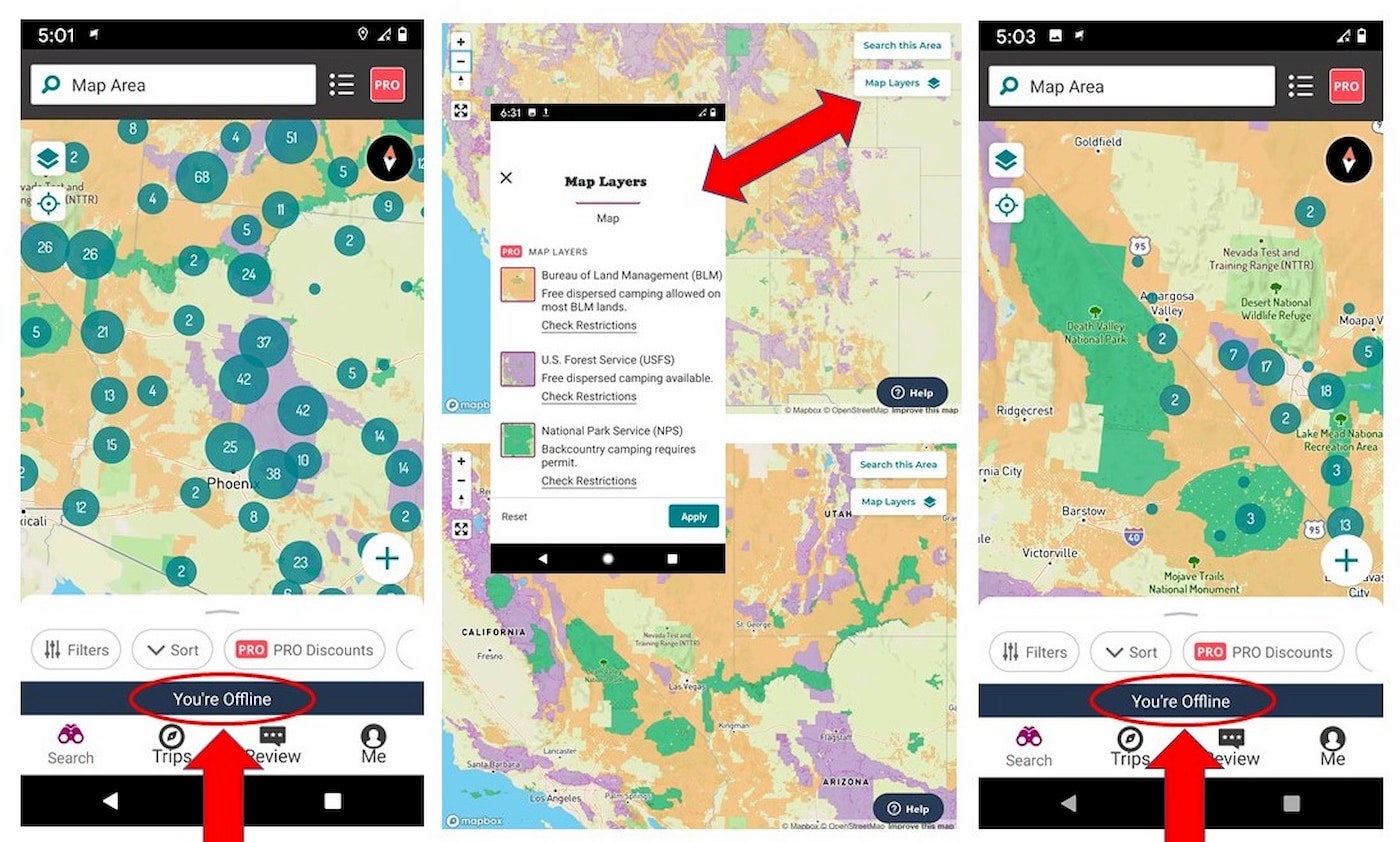
We rolled into Quartzsite, Arizona, in late January and discovered suddenly that we weren’t the only ones with the idea of spending some time in the Sonoran desert. Quartzite draws nearly 2 million RVers each winter, but with millions of acres of BLM land within 25 miles of this tiny hamlet of less than 4,000 year-round residents, we were still able to find a quiet corner to call our own. Quartzite is known as a desert boondocking destination in the winter. Nearly every kind of RV, motorhome, 5th wheel, van, toy hauler, travel trailer, and tent could be found scattered across the landscape. Within the La Posa Long-Term Visitor Area, run by the BLM near Quartzite, folks can stay for up to 8 months for less than $200 and have all the services they need within a short drive.
Desert Diversity
We wandered into canyons, valleys, and up hilltops, where we were the only humans in sight. We hiked into areas which most people reach by OHV, but no matter how you get in, the wonders remain the same. The evidence of prehistoric humans abounds throughout the region and proves that our millennia isn’t the only one to hear the desert’s call. From pictographs and grain pounding holes, to cave dwellings perched high up a sandstone wall, what remains from those who came before can be a constant companion as you explore these regions.
Nature also taught us valuable lessons in respect. We drove up a winding dirt road, which crossed several washes, up to Cochise Stronghold in the Dragoon Mountains of southern Arizona for a night of camping and a forecast of light rain. We awoke to 3.5 inches, and a wall of water rushing across the washes keeping everyone in place for the next few days. Fortunately, we had plenty of food, enough to share with the campers next to us, who had only brought enough for the night. A good camaraderie emerged among the other stranded campers as we simply accepted what we could not change and enjoyed every last minute of it.
If your timing is right, you might be rewarded with nature’s abundant beauty. Last winter, desert super blooms stole the headlines — and we were right in the middle of it all. Rolling into a camping space at dusk gives little indication of what flowers might be pushing up all around you. In the morning, our curiosity was rewarded by vast fields of little solar panels of yellow and orange blanketing the landscape — California Poppies as far as we could see. The conditions were perfect for this little wildflower, and many others, to capture the world’s attention.
The Ideal Location for Solar Boondocking
Because we boondock with solar as our main source of power, living in the desert is a no-brainer in the winter. We have a small 100W Renogy folding solar suitcase, a portable solar panel that we set up on about 20 feet of extension cord. We can set the camper in an ideal position, perhaps even some shade, and place the panel out in the sun. With the abundance of sunshine, at all altitudes, our battery was always back up to 100% charge by 10 am. Frankly, we never ran out of energy, nor even worried about it. Going solar frees us up to enjoy these areas right up to our stay limit. All we need is an occasional resupply of water and groceries…and a laundromat.
Interested in going solar? Read our Complete Guide to Solar for the New RVer.
Can you name the four deserts in North America?
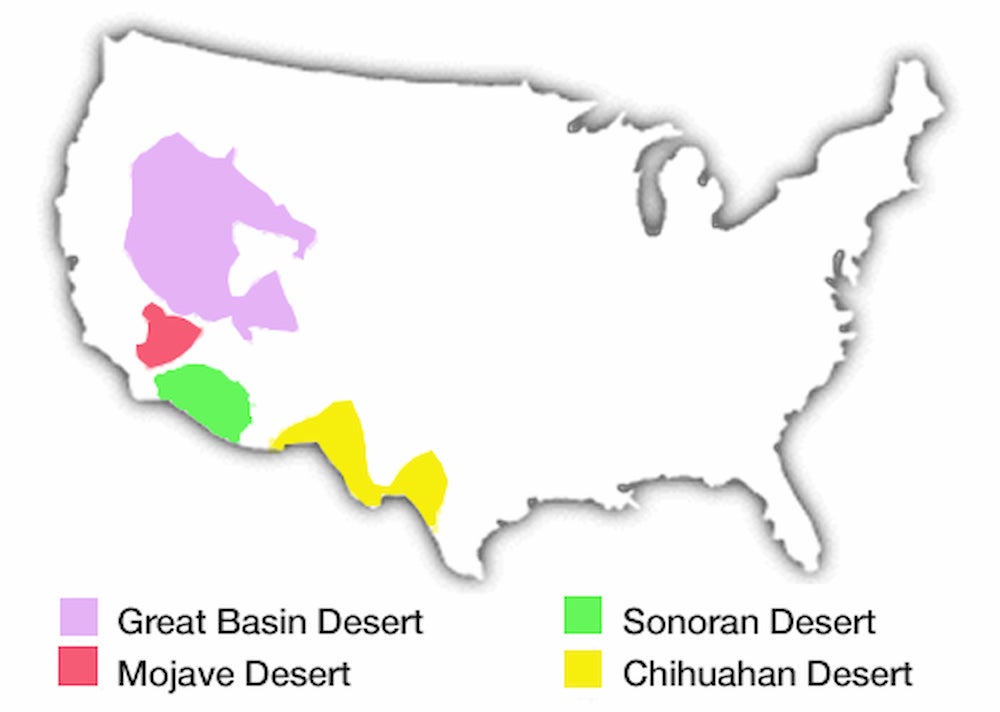
Image from desertusa.com
Since we’ve found that most people struggle to name even one, we’ve included a bit of natural history and geography in addition to discussing some highlights in each region.
While we did not find reservations necessary in 2019, travel restrictions due to COVID-19 have renewed our nation’s interest in camping; traffic to The Dyrt’s website alone has increased by over 400%. If you are the type that loves to have all of your details planned out, The Dyrt PRO’s Trip Planner is perfect for you. Find top-rated campgrounds in your price range along your route, make reservations (if applicable), and plan out your route!
1. Great Basin Desert
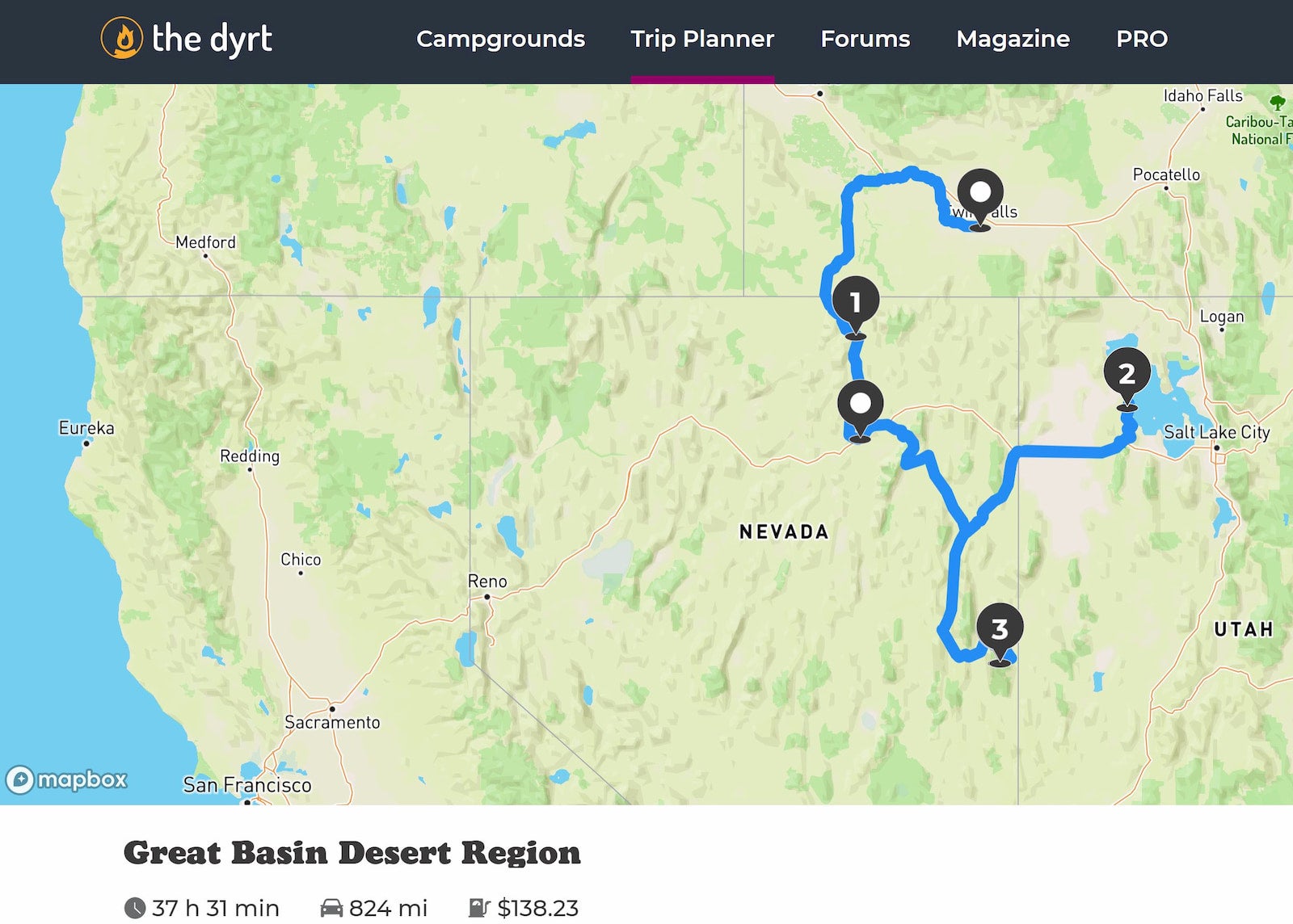
Bordered by the Sierra Nevada range to the west, the Wasatch Mountains to the east, the Columbia Plateau to the north, and the Mojave Desert to the south, its distinctive natural feature is rugged north-south trending mountain ranges interspersed with broad sweeping valleys. It is classified as a cold, mid-latitude desert and covers an arid expanse of about 190,000 square miles, making it the largest of the North American deserts. Due to its remoteness, this desert does not draw many visitors.
Hwy 50 cuts through a vast and sparsely inhabited interior of Nevada. Known as the “Loneliest Road in America,” this route makes you feel it, but if you have the time, you can feel it in a good way. Few places on the continent offer the perspective of road and landscape like this. Cresting one small mountain ridge you see the road as a great unbroken ribbon plunging straight as a surveyor’s line down into the valley below and up the next ridge some 10 to 15 miles distant. Here you can go your own speed, making it ideal for RVers hauling some extra weight to really take their time on this scenic RV desert cruise. It is not unlike being out on the ocean with nothing but the vastness of water and a compass heading to define you.
One of our destinations was the Upper Lehman Campground at Great Basin National Park, which we thought would be in celebration of this immense landscape. Rather, it is a specific mountain range that towers above this desert ocean like an “island” in the sky. It is the elevation above that is celebrated here and the home of the millennia spanning Bristlecone Pine which grows at only 10,000 feet or higher. Though winter had mostly passed by early April, we were still treated to its leftover storms and needed our snowshoes to truly enjoy the park because the roads at higher elevations were still closed. Even with these tools, we were still unable to climb high enough to reach the Bristlecone’s habitat….an adventure for next time!

A Few of Our Favorites In/Near this Desert:
- Great Basin National Park
- The Great Salt Lake
- Humbolt-Toiyabe National Forest
- I.B. Perrine Bridge Visitor Center (BASE Jumping)
- Ruby Mountains
- Shoshone Falls Park
- Snake River
- Wild Horse Reservoir State Recreation Area
2. Sonoran Desert
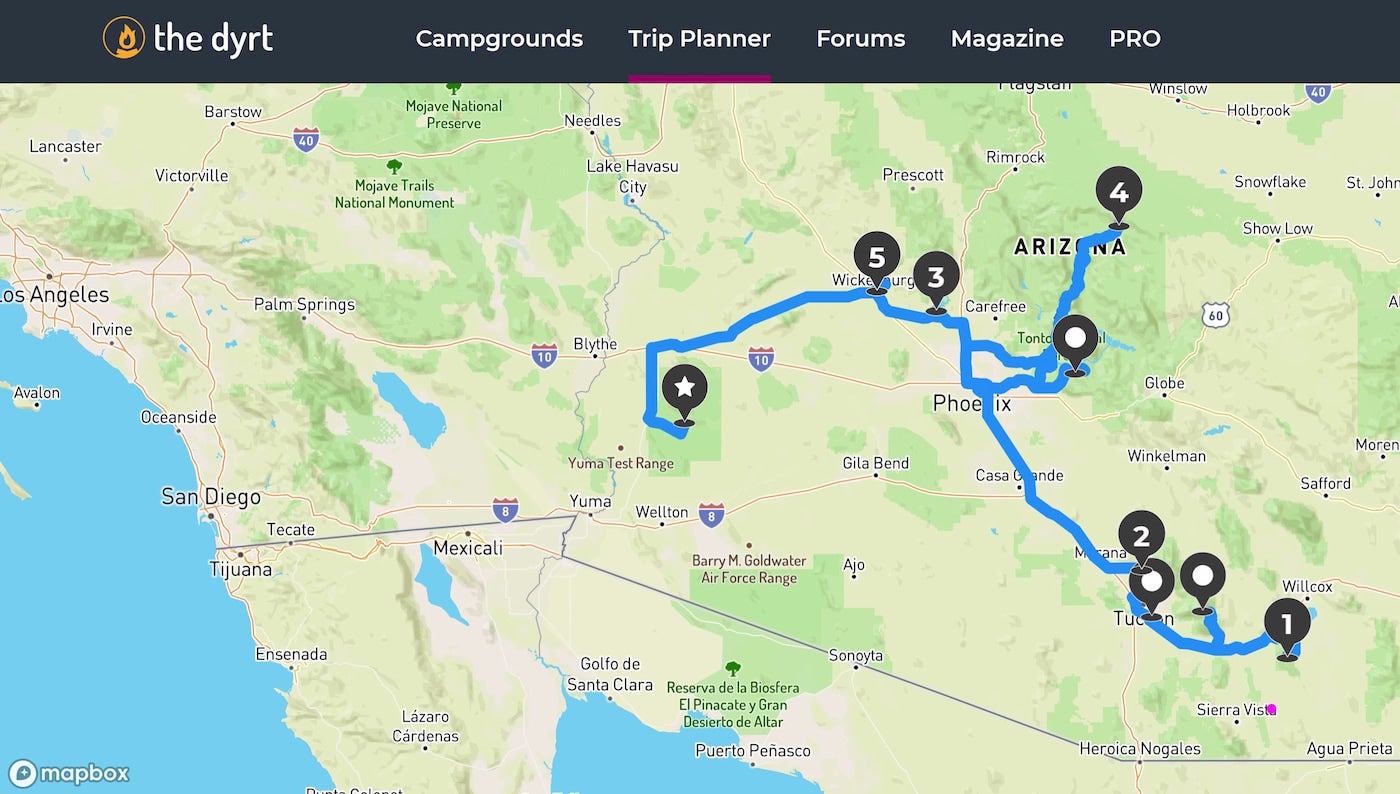
Covering 120,000 square miles in southwestern Arizona and southeastern California, U.S., and including much of the Mexican state of Baja California Sur, part of Baja California state, and the western half of the state of Sonora, the Sonoran Desert has a subtropical climate and receives 3 to 15 inches of rain per year. Most of the precipitation comes during monsoon season (July–September), when strong, brief thunderstorms bring heavy rain. Typically, lighter winter rainfall also occurs. A distinctive feature of the Sonoran Desert is the majestic Saguaro cacti, many of which are hundreds of years old. The mountain ranges dotted amongst this desert create a diversity of ecosystems rising above the desert floor, creating wetter and cooler “Islands in the Sky.”
We had no idea what we were getting into when we approached the Sonoran Desert Museum just outside of Tucson, Arizona. But the moment we saw the words, “hummingbird enclosure” on our map, we knew we were going to spend the rest of the day taking it all in. “Should we get an annual pass and come back again tomorrow?” Shari asked. We are unapologetic nature nerds, and though it was only 10am when we arrived, we were the last patrons to leave at closing time.
This interactive outdoor museum is a love poem to the ecosystem it celebrates. Just a 10-minute bike ride from Gilbert Ray Campground, a truly lovely place that does not accept reservations, spending several days here is not only possible, but easily accomplished. Indeed, it takes more than one day to fully appreciate.

A Few of Our Favorites In/Near this Desert:
- Arizona National Scenic Trail
- Arizona-Sonoran Desert Museum
- Cochise Stronghold
- Kofa National Wildlife Refuge
- Quartzite & The Rubber Tramp Rendezvous
- Saguaro National Park
- Superstition Mountains
- Tonto National Monument
- Tonto National Forest
3. Mojave Desert
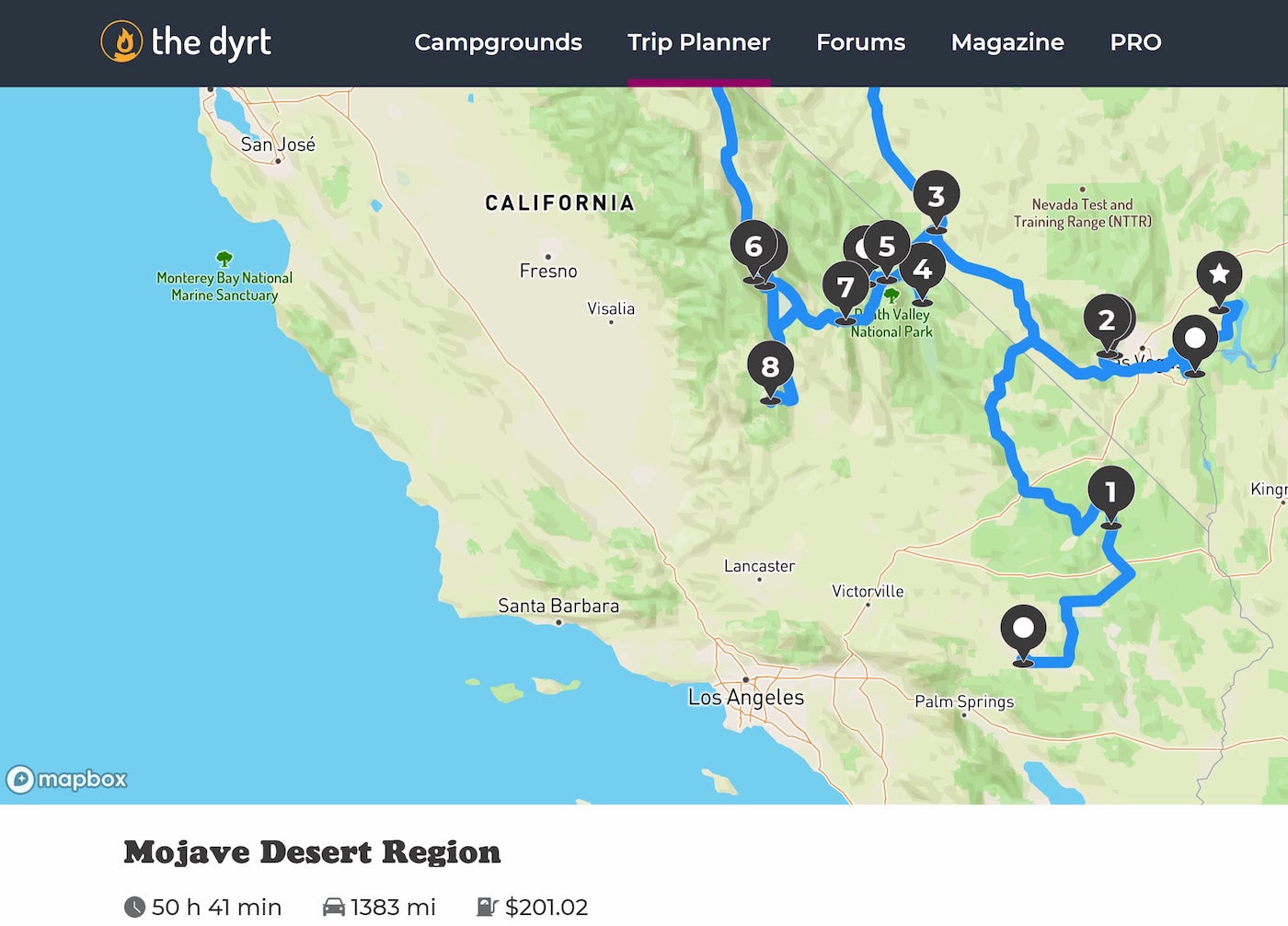 “Shari! Don’t move!” I hissed. She froze and scanned the immediate vicinity for the thing about to bite her. But it wasn’t danger that had caught my eye, it was fascination. About 20 feet off the trail winding through the brilliantly colored sandstone of Valley of Fire State Park, there stood a Desert Tortoise, one of the more elusive creatures of the desert. We’d just learned from a park ranger in the Atlatl Rock Campground that seeing one of these shy beings is a very rare treat. I didn’t want Shari to miss out.
“Shari! Don’t move!” I hissed. She froze and scanned the immediate vicinity for the thing about to bite her. But it wasn’t danger that had caught my eye, it was fascination. About 20 feet off the trail winding through the brilliantly colored sandstone of Valley of Fire State Park, there stood a Desert Tortoise, one of the more elusive creatures of the desert. We’d just learned from a park ranger in the Atlatl Rock Campground that seeing one of these shy beings is a very rare treat. I didn’t want Shari to miss out.
We carefully and cautiously approached. Frightening these animals by getting too close or picking them up can cause them to lose much of their stored water. In an effort to escape, they urinate out what they’ve stored for months, and in the desert it can be difficult, or impossible, to replace. Being too eager appreciators can be a death sentence for these ancient creatures.
We watched it casually wind its way through a rocky path that it seemed to know well, stopping to inspect a Beaver Tail Cactus, whose small, red fruit are one of its favorite foods. With the phone camera rolling, and Shari enthusiastically whispering in my ear, “He’s gonna eat the Beaver Tail! He’s gonna eat the Beaver Tail!” I captured the moment when this little fellow chomped down on his breakfast. We followed from a respectful distance as he slowly walked away between overhanging boulders to seek out some shade from the relentless desert sun.
Named for the Mojave people, the Mojave Desert occupies more than 25,000 square miles — extending from the Sierra Nevada range to the Colorado Plateau and merges with the Great Basin to the north and the Sonoran Desert to the south and southeast. The fascinating Joshua Tree is unique to the Mojave area, as it’s the only place where it thrives. Seeing the first of these spindly plants with its branches reaching plaintively in all directions might be the only landmark clue that you have actually arrived in the Mojave.
A Few of Our Favorites In/Near this Desert:
- Alabama Hills
- Death Valley National Park
- Joshua Tree National Park
- Lake Mead National Recreation Area
- Manzanar National Historic Site
- Red Rocks Canyon National Conservation Area
- Valley of Fire State Park
4. The Chihuahuan Desert

Just east of the Sonoran Desert lies the huge Chihuahua Desert. With an area of about 140,000 square miles, it is the second-largest North American desert. It occupies much of western Texas, portions of the middle and lower Rio Grande Valley and the lower Pecos Valley of New Mexico, and parts of southeastern Arizona, as well as the central and northern portions of the Mexican Plateau. Lechuguilla (Agave lechuguilla), one of the indicator plants, is found only in this desert. It flowers just once in its lifetime, then promptly dies.
On Christmas morning, we found ourselves in the Chiricahua Mountains of southeastern Arizona. A simple note on the pit toilet door alerted us to a casual holiday brunch in the late morning at the camp host’s site. “Bring something to share, or just bring yourself!” the note cheerily read. We made our favorite coffee cake in our Fry Bake pan over the fire pit and joined in.
The camaraderie of strangers who suddenly form a community over a shared meal is always an enriching experience, and we lingered long into the afternoon. I retrieved my guitar from the trailer and folks gathered around the fire ring for music, and conversation. With just a small gathering, our dear camp host Peggy exceeded our wildest expectations about her job at the Sunny Flat Campground. And, this is just one of dozens of other surprises that we found within these mountains and within this desert.

A Few of Our Favorites In/Near this Desert:
- Big Bend National Park
- Carlsbad Caverns
- Chihuahuan Desert Research Institute
- Chiricahua National Monument
- Guadalupe Mountains
- Hot Wells Dunes Recreation Area
- McDonald Observatory
- White Sands National Park
Our Tips for Enjoying the Desert in the Winter
Whether camping just outside of Tucson, or a hundred miles from anywhere in Nevada, the motto for visiting the desert is “be prepared.” With a little planning and an ounce of adventurous spirit, you too can answer the desert’s calling…safely.
Go Solar:
- The options for campgrounds and RV desert boondocking are limitless. You won’t need to stay in RV parks or expensive “hook up” campgrounds, or even make reservations. The Dyrt PRO app is the perfect companion to find campgrounds and public land across these regions.
Stay Hydrated:
- Drink lots of water and always carry plenty of extra water with you, even if you are just driving an hour to your next destination. The dryness can dehydrate you very quickly even in cooler weather. If you get a headache, you are probably already on your way to dehydration.
- Nearly every grocery store or gas station has a reverse osmosis water filling station. Bring your jugs and fill up for drinking water
- When the weather is warm, dip your hat in cold water before putting it on your head. It’ll keep you cooler than just putting it on dry.
Don’t Miss:
- Sunrises and sunsets are the best light of the day. Even if you are not a morning person, try to get up and watch the sunrise a few times. It will set your day right.
- Bring your boats, there’s plenty of water for paddling everywhere, just be sure to stop at each Boat Inspection Station to get checked and cleared for invasive species.
Be Aware Of:
- Creeks and washes can rise quickly with just a bit of rain. Never cross water unless you know how deep it is and can assess its flow. Turn around, don’t drown.
- Be aware, but not afraid of snakes. We didn’t see a single one in 4 months as they are cold-blooded and don’t really like being outside in the cooler months.
- Be aware of where you put your feet and hands while climbing around on rocks. Everything in the desert pokes, stings, scratches, and bites.
- Cholla cacti are like painful velcro and they stick to absolutely everything. Bring a hair pick or long-toothed comb with you when hiking or mountain biking to remove this unwanted friend from your shoe, leg, etc.
- While mountain biking, always bring extra inner tubes as well as a patch kit. We went through 2 inner tubes per week, even with Slime protection in our tires.
- While there may not appear to be life in the desert soil, it is very fragile. Cryptobiotic soil can take hundreds of years to regrow if accidentally stepped on. Watch where you step!
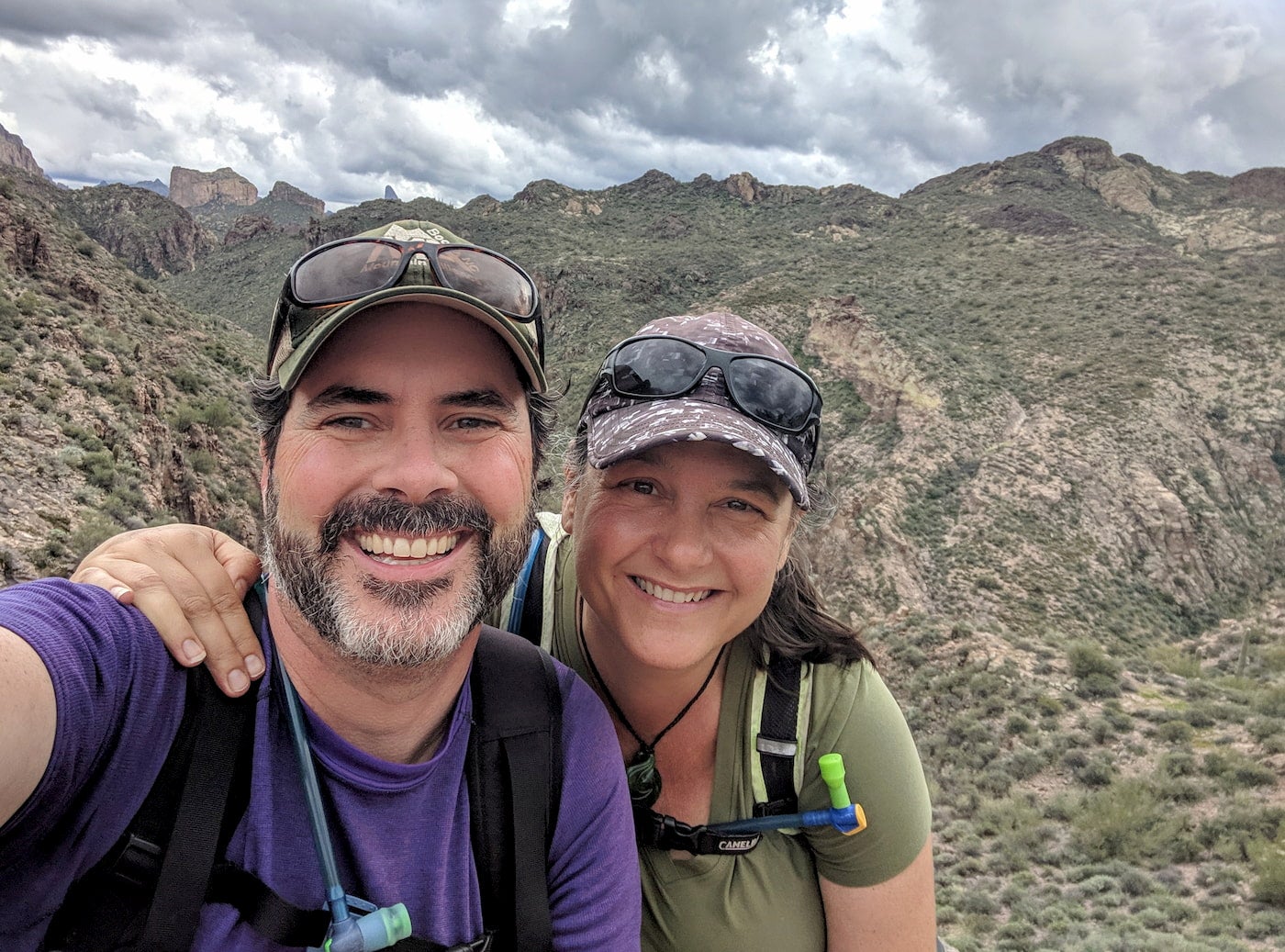
Shari Galiardi & David Hutchison have turned their higher education backgrounds, desire for life-long learning, and thirst for adventure travel into writing, photography, video production, and public speaking tours from coast to coast. Known to their friends as simply Shari & Hutch, you can learn more about their full-time, solar-powered adventures on their website at freedominacan.com. Or, follow them on Facebook, Instagram, and YouTube as “Freedom in a Can.” They have been involved with The Dyrt since 2016.
The post Desert Boondocking: Four Months, Four Desert Ecosystems appeared first on The Dyrt Magazine.


